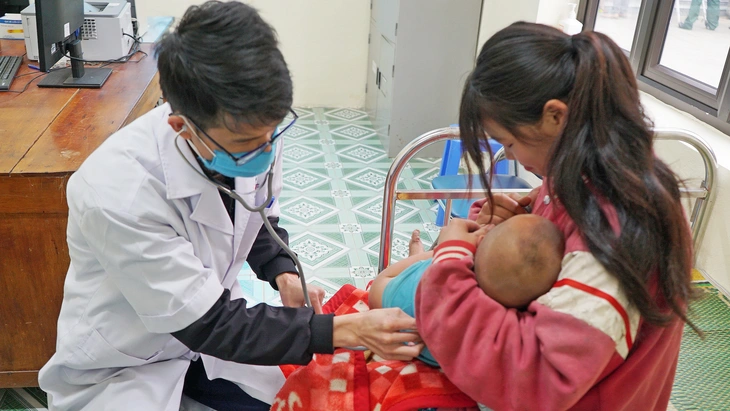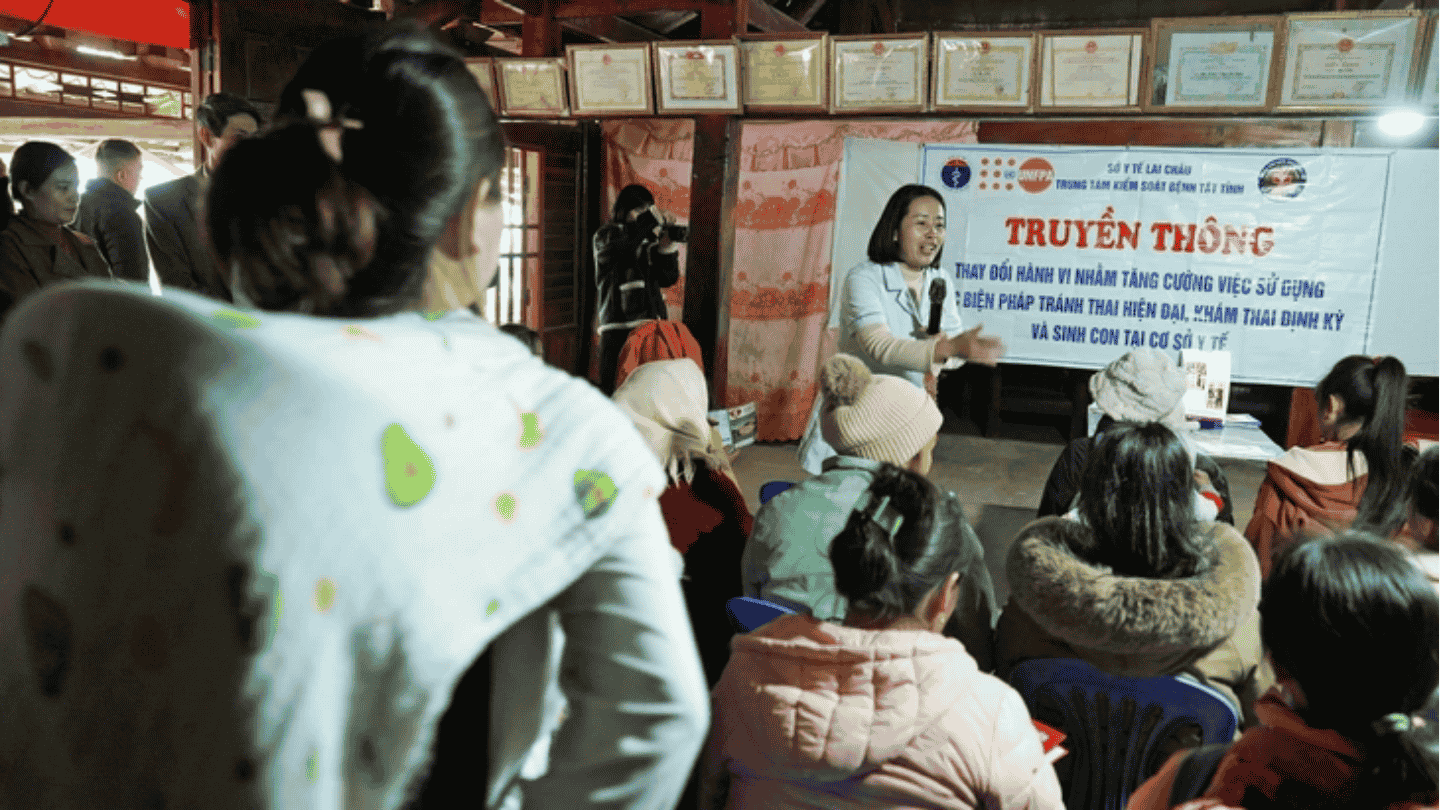One of the greatest barriers to reducing maternal mortality here is changing the perceptions, customs, and practices of ethnic minority communities.
In recent years, although the rate of giving birth at medical facilities has increased significantly, across the country, there are still more than 10% of ethnic minority women who do not give birth at health facilities. Sadly, the mortality rate for ethnic minority children under one year old reaches up to 2.2%.
Despite medical stations being equipped with modern devices and healthcare staff continuously improving their skills and expertise, the rate of home births in highland and ethnic minority areas remains high. The maternal mortality rate in mountainous and ethnic minority areas is 2–3 times higher than the national average.
Eliminating the Custom of Home Birth
Again, one of the greatest barriers to reducing maternal mortality here is changing the perceptions and customs of ethnic minority people.
Ms. Lò Thị Thanh, a physician working at Mù Sang Commune Health Station in Phong Thổ District, Lai Châu Province, shared that she once had to persuade an entire family to take a pregnant woman to the district hospital to give birth. She recounted that the woman was having a difficult labor, and the family had called her to the house for assistance.
“When I arrived, I realized the woman was in poor condition and could not give birth naturally, so I told her husband and mother-in-law to take her to the district hospital. But the whole family refused. I had to say directly to the mother-in-law: ‘If it were your daughter in the same difficult labor, would you dare keep her at home knowing she might die if not taken to the hospital?’ Only then did the family agree,” Ms. Thanh recalled.
It's not just about raising awareness among the women themselves — in ethnic minority areas, grassroots health workers must also communicate with the whole family and relatives so that they understand and accompany the mother through childbirth.

Barriers to “Overcoming Labor” in Highland Areas
Mr. Nguyễn Thế Phong, Deputy Director of the Lai Châu Provincial Department of Health, stated that the maternal mortality rate among ethnic minority communities in the area remains high. The reasons are related to geographical, cognitive, and health infrastructure barriers.
“The medical station staff, together with local officials, often go to the villages and coordinate with village heads, elders, and clans to raise awareness among the people about the dangers of giving birth at home and the benefits of delivering at health facilities to ensure the health of mothers and newborns. But changing people’s awareness cannot happen overnight.”
Language differences, many women not knowing the national language, and the fact that people often work in fields or faraway shelters also make it difficult for health workers to reach them and carry out communication efforts, Mr. Phong said.
During a monitoring visit to assess the progress of the project “Leaving No One Behind: Innovative Interventions to Reduce Maternal Mortality in Ethnic Minority Areas in Viet Nam” in Lai Châu Province, Mr. Matt Jackson, UNFPA Representative in Viet Nam, said that the maternal mortality rate in ethnic minority communities remains high due to difficulties in accessing health facilities in mountainous regions.
Mr. Matt Jackson noted that the greatest challenge relates to location and terrain. The distance from households to district health centers or commune medical stations is often 10–15 kilometers. Travel becomes even more difficult during the rainy season or floods.
“Another major challenge lies in traditional customs, where many women still want to give birth at home. Language barriers also pose difficulties, which is why we need creative, engaging, and easy-to-understand communication methods to convince people why it is safer to deliver at health facilities.
In reality, the results achieved are quite encouraging. For example, we can see that the proportion of mothers coming for checkups and giving birth at health facilities in these areas has significantly increased in recent years,” said the UNFPA Representative.
“Slow Drip Penetrates Stone” and Social Welfare Policies
Ms. Trần Thị Bích Loan — Deputy Director General of the Department of Maternal and Child Health, Ministry of Health — assessed that changing the awareness of ethnic minority people will take time due to long-standing traditions.
“We still have limitations in facilities and healthcare workforce to ensure the delivery of services to ethnic minority people. This is one of the reasons leading to gaps in screening, examination, and early detection of signs of obstetric complications and maternal death,” Ms. Loan said.
Ms. Loan emphasized that, along with state budget resources, international cooperation to enhance equipment and financial support for disadvantaged mountainous provinces is an important solution.
Giving Birth Costs Nothing — and You Get Paid
Living halfway up a mountain in Phong Thổ District, Lai Châu Province, Mr. Giàng A Lừng (22 years old) and Ms. Lý Thị Số (21 years old), from Xin Chải village, Mù Sang commune, play joyfully with their two small children. Two years ago, Ms. Số gave birth to her first child at home. For the recent second birth, she was taken by her husband to the health station for a checkup and gave birth at the facility.
Mr. Lừng shared that he had heard village leaders and health officials advocate many times, so he took his wife to the health center. “We thought giving birth at the clinic would be expensive, that we’d have to stay there long, waste time and money — so we always gave birth at home. But it turns out that’s not the case. My wife gave birth and came home the next day. It didn’t cost us anything, and the staff even gave us an extra 500,000 VND,” Mr. Lừng said honestly.
Similarly, Ms. Vàng Thị Sùng’s family, after giving birth to two children at home, brought her to a health facility in 2023 to give birth. In Mù Sang commune, the rate of births at health facilities increased from 24% in 2022 to 61% in 2024, and the rate of women receiving regular prenatal checkups rose from 27.2% to 41.7%.
According to Ms. Thanh, the health station is now better equipped, with handheld fetal heart monitors and clean delivery rooms. Notably, the “Leaving No One Behind” project — innovative interventions to reduce maternal mortality in ethnic minority areas in Viet Nam, implemented by the Ministry of Health in collaboration with UNFPA and MSD — also provides travel cost support of 500,000 VND for mothers giving birth at commune health stations.
Thanks to this support, people are beginning to change their awareness and habits — opting for births at medical facilities instead of at home.
These policies have begun to show results. The national maternal mortality rate has shown encouraging improvements. In 2023, the maternal mortality rate decreased more than fivefold, from 233 per 100,000 live births in 1990 to 44 per 100,000. The under-5 and under-1 child mortality rates also dropped nearly fourfold.
However, reducing the rate of home births in mountainous and ethnic minority regions remains a challenge and will continue to require new steps and policies.
@Tuoi Tre/Duong Lieu


